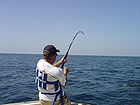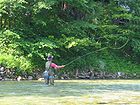- Muddler Minnow
-
 The Typical Muddler Minnow Pattern
The Typical Muddler Minnow PatternThe Muddler Minnow is a popular and versatile artificial fly of the streamer type used in fly fishing and fly tying.
Contents
History
The Muddler Minnow was spawned, so to speak, by Don Gapen of Anoka, Minnesota in 1937, to imitate the slimy sculpin. Gapen developed this fly to catch Nipigon strain brook trout in Ontario, Canada. The Muddler, as it is informally known by anglers, was popularized by Montana, USA fisherman and fly tier Dan Bailey. It is now a popular pattern worldwide and is likely found in nearly every angler's fly box, in one form or another. Due to its universal appeal to game fish, the muddler minnow will remain as an integral tool in sport fishing.
Imitations
The versatility of the Muddler Minnow stems from this pattern's ability to mimic a variety of aquatic and terrestrial forage, ranging from sculpins, to leeches, to grasshoppers, crickets, spent mayflies, emerging green drakes, stonefly nymphs, mice, tadpoles, dace, shiners, chubs, and other "minnows," along with a host of other creatures.
Construction
There are limitless material and colour variations, however the essence of the Muddler Minnow is a spun deer hair head. While each Muddler may differ in colour or profile, all true Muddlers have a fore-end or body of spun deer hair that is clipped close to the shank to provide a buoyant head. Typically there is an underwing of squirrel hair and a wing of mottled secondary turkey feather. Often the fly body is made of gold/silver Mylar or tinsel wrapped around the hook shank. Marabou may be tied in as a substitute wing for colour and life-like movement through the water. The head may be weighted or unweighted, according to the style of fishing, the target species and the intended imitation. The muddler has served for the basis of several patterns, including the Spuddler, Muddler Hopper, Mizzoulian Spook, Searcy Muddler, Keel Muddler, and so on, but even in its simplest and original form, it remains a very effective fly.
Besides the traditional deer hair, many Muddlers are tied today with heads made of antelope, spun wool, dubbing, chenille, or other materials. Whether they should properly be called Muddlers is a moot point.
Note that the fly pictured above, while typical, is not a traditional Muddler Minnow. The traditional Muddler uses brown mottled turkey quill segments for both tail and wing. It also seems to lack the underwing of gray squirrel tail. As originally tied by Don Gapen (and as still tied by The Gapen Company today), the Muddler Minnow's head was sparse and "raggedy," the head and collar being fashioned from a single clump of deer hair. The dense head featured on most of today's Muddlers was the invention of Dan Bailey, ca. 1950, because Muddlers were mainly used to imitate large grasshoppers out West back in the 1950s,
Target Species
Muddler patterns are generally effective when fishing for any freshwater or saltwater species in cold or warm water environments. This pattern is most often used to catch all species of trout, steelhead, Arctic char, large grayling, both Atlantic and Pacific salmon, taimen, lenok, smallmouth and largemouth bass, pike, redfish (red drum), tarpon, and almost anything else that swims.
Fishing the Muddler
Effective retrieval tactics include stripping the floating Muddler across the water surface rhythmically, imparting a "wake", or allowing the Muddler to sink and twitching or pulsating it against or across a river's current. An unweighted Muddler will float and appears as a hopper, moth or struggling mouse. With a tiny piece of split shot in front of it (or an intermediate flyline) the Muddler can be made to swim slowly over weedbeds and shallow gravel bars. With more weight, the Muddler can be stripped wildly in the shallows to imitate and alarmed baitfish, or allowed to settle in deeper water. When weighted--either on the fly itself, with split shot, or a sinking leader or line--the Muddler my be fished right on the bottom to effectively imitate a sculpin. When imitating sculpins, Muddlers must be kept right on the bottom and fished slowly, with occasional fast strips of maybe a foot to a yard, as if trying to escape a predator.
Tied on salmon hooks in sizes 2 to 10, the Muddler (and don't forget the Marabou Muddler)is an excellent fly for Atlantic salmon. It can be fished on the swing, like a typical salmon wet fly or it can be fished in the surface film as a waking fly. Use of the Portland Creek riffle hitch is desirable, but not entirely necessary, to effectively wake a Muddler. Muddlers tied on salmon double hooks are particularly good waking flies. Know that salmon will often follow the waking fly and will not take until the end of the waking drift. For this reason, it's always a good idea to let the Muddler wobble in the current at the bottom of the drift and twitch it a few times before casting again. (This is also a good technique for trout, especially large trout.)
References
- Peter Gathercole (2003). The fly-tying bible: 100 deadly trout and salmon flies in step-by-step photographs. Aurum Press. ISBN 978-1854108654
- Soucie, Gary. Muddler Magic: How to Tie and Fish Muddler Minnows and Other Mostly Muddler Patterns. Frank Amato Publications (in process).
External links
- The Trail from Gateway Lodge. - The History of Gapen
- Recipe, tying instructions, variations, uses and how to fish
- [1] - The Global Fly Fisher/Muddler Mania
Fisheries and fishing topic areas Fisheries 
Fishing - Fisherman
- Artisan fishing
- Fishing villages
- Fishing vessels
- Fishing history
Industrial Recreational Techniques Tackle Locations - Fishing by country
- Fishing villages
- Fishing banks
- Fish ponds
- Marine habitats
- Index of fishing articles
- List of fishing topics by subject
- Fisheries glossary
Categories:- Streamer patterns
Wikimedia Foundation. 2010.


